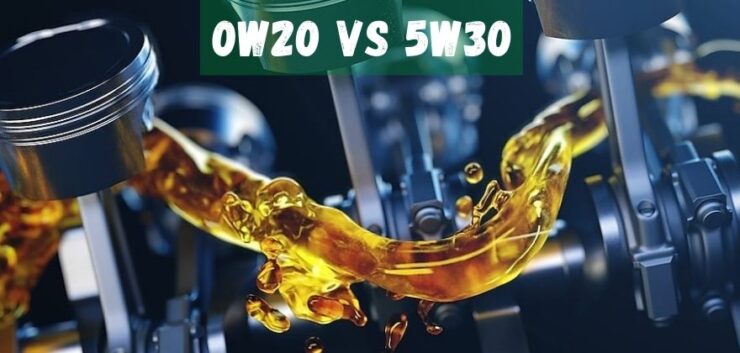The two most commonly used engine oils are 5w30 and 0w20. The difference between these oil types are their viscosity or thickness. 5w30 is a thicker oil that provides better protection against heat.
it can withstand high temperatures before flowing out of your engine. This makes it perfect for colder climates where the car isn’t being driven so much in the winter months.
0w20 vs 5w30

0w20 is more appropriate for cold weather conditions.
5w30 will give you better protection against hot temperatures, but it will perform less well in colder climates than the thinner oil does.
That’s because the molecules of 5w30 are taller and can’t pack as tightly together as those of 0w20, which is considerably more slippery. Thin oils flow easier to where they’re needed during start-up and at low speeds (a car needs every gear to work smoothly at always-high engine speeds).
It all depends on your climate; which type of oil would be best varys depending on where you live. If you live in an area that has very cold winters with snow, scraping ice off windows or driving around under
0w20 engine oil
0w20 engine oil is a viscosity index class of engine oil, where w stands for winter and 20 in the year.
0w in classification means it behaves like a thinner oil when below 0 degrees Celsius/32 degrees Fahrenheit.
It is used when the environment temperature ranges from very cold (-5°C or 23°F) to milder temperatures or when it is impossible to add an anti-gelling additive in the crankcase to function properly.
Benefits of 0w20 engine oil
It is a motor oil with an ILSAC (International Lubricant Standardization and Approval Committee) grade designating it as appropriate for use in most passenger cars but not for use.
It will be exposed to extreme situations such as racing or frequent stops and starts.
Oil performance typically degrades over time; such degradation effects include sheen (oil can change color due to contamination), and viscosity (consistency of the oil).
Other things that may cause your vehicle’s engine to need an oil change are abnormal operation sounds coming from the engine, indicator lights on dashboards, smoky exhausts because of lack of sufficient lubrication.
5w30 engine oil
5w30 engine oil is a classification for the grade of motor oil. It’s also known as “all round” or “universal” grade.
Motor oils are labeled with a viscosity index (VI), which indicates the relative thickness of the lubricant at low, cold temperatures without extraneous chemical additives (Thin will be less than 11; Middle is 11-16;
Thickness would be over 16) and gives some indication on how well it can handle extreme change in operating temperature.
Here, the 5w30 refers to its viscosity on a scale of 1-100 (W= winter). The “30” indicates 30 degrees Celsius ambient temperature on the SAE 20 engine friction dynamometer test cycles –
Benefits of 5w-30 oil
Is 5w30 better than 0w20, Or Can I replace 0w20 with 5w30?
It’s a question we get asked A LOT, and for a good reason. The oil you use can have a big impact on your car’s performance, and it is no small thing to change the viscosity of the liquid that keeps everything running smoothly. So what’s right for your car?
The best answer, in our opinion, is pretty simple. Use the oil viscosity (5w30, 0w20, etc.) that your car manufacturer specifies. If they say 5w30, go with it! If they want you to use 15w50 or straight SAE 50, then do it! The specs are put in place by the manufacturer for a reason. As long as you are using the oil they specify, you don’t have to worry about damaging your car or voiding your warranty. It’s that simple!
But what if you want to get more technical? Well…it gets a little trickier, and opinions get involved. So let’s break it down.
What are the main reasons people change viscosity?
Three reasons come to mind:
- The manufacturer,
- require it. The owner wants better “mileage” from their engine oil.
- They want improved protection during colder weather conditions.
The first reason is easy to understand. The manufacturer changes oil viscosity for a reason, including optimizing performance and protecting the engine.
If you want your car to run at its best, changing to the oil it specifies makes sense. But if you aren’t experiencing any issues, this may not make sense from a financial perspective (a good quality oil will cost you anywhere from $6-$10/qt for 5w30).
There is no sense in spending the extra money if your car isn’t experiencing any problems.
The second reason is a little trickier and has to do with how engine oil works.
The science behind lubricant technology can be difficult to understand, but we’ve done our best to simplify it in a way that is easy to understand.
What temp is 0w20 good for?
0w20 is a universal viscosity rating used for all engines that specify 5w20 (obviously, you cannot use 0w20 in place of 5w20). So what does it mean? The “0” stands for the zero warm-up periods, and “20” stands for the high end of the viscosity range.
So 0w20 has a minimum viscosity rating of 3,3mm2/s at -30C (-22F). This is equivalent to around 5w in standard, but you can use it when it is colder outside because it’s a lower number.
Conclusion
It’s important to understand the difference between 0w20 and 5w30 oil. If you’re unsure which one is right for your car, talk with a qualified automotive professional like us at GoMentum Station in San Francisco.
We’ll be glad to get you set up with an appointment so we can take care of all of your automobile needs!

